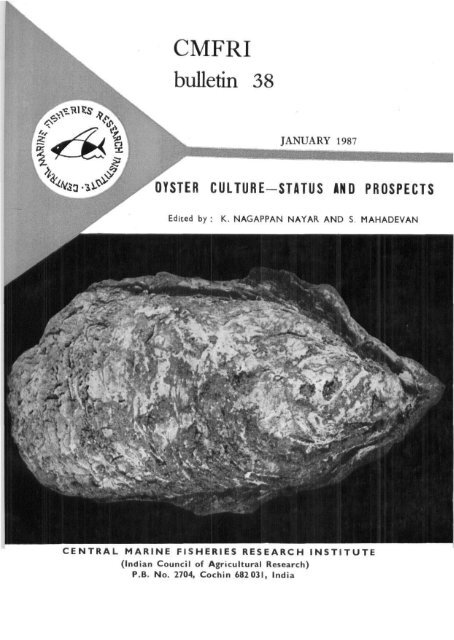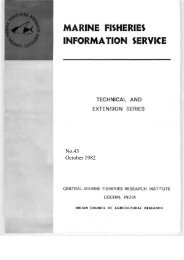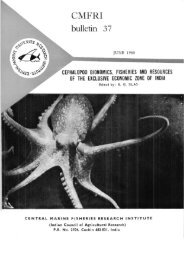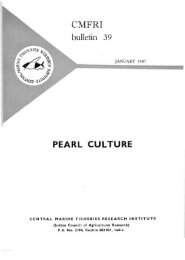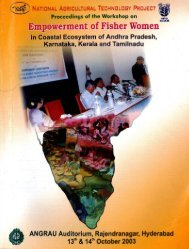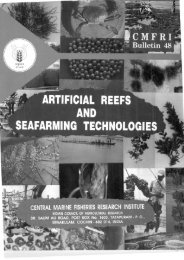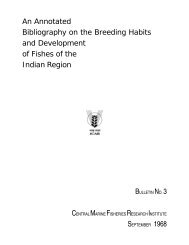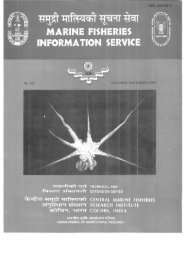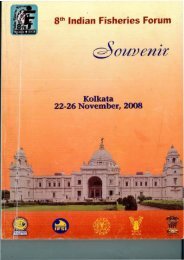te.^i. - Eprints@CMFRI - Central Marine Fisheries Research Institute
te.^i. - Eprints@CMFRI - Central Marine Fisheries Research Institute
te.^i. - Eprints@CMFRI - Central Marine Fisheries Research Institute
You also want an ePaper? Increase the reach of your titles
YUMPU automatically turns print PDFs into web optimized ePapers that Google loves.
JANUARY 1987?^<strong>te</strong>.<strong>^i</strong>.^OYSTERCULTURE-STATUS AND PROSPECTSEdi<strong>te</strong>d by : K. NAGAPPAN NAYAR AND S. MAHADEVANCENTRAL MARINE FISHERIES RESEARCH INSTITUTE(Indian Council of Agricultural <strong>Research</strong>)P.B. No. 2704, Cochin 682 031, India
11ECONOMICS OF OYSTER CULTUREK. NAGAPPAN NAYAR^, S. MAHADEVAN^ AND P. MUTHIAH'INTRODUCTIONEconomic analysis of any sys<strong>te</strong>m of aquaculturepractice aids not only to improvise managementpractices but also ensures profitability. At<strong>te</strong>ntion onreturn on investment has bsen rightly emphasized byMitcheU and Usry (1967), PiUay (1973) and IPFC(1975) to show that well planned and propsrlymanaged aquaculture ventures compare very favourablywith similar other food production industries. Homell(1910) realising the edibility of the oys<strong>te</strong>r meat and itsnutritional value initia<strong>te</strong>d efforts on oys<strong>te</strong>r farming atPulicat Lake and gave an approxima<strong>te</strong> account ofworking expenses of a one ha. park. These estima<strong>te</strong>sare not relevant to the present day cost but neverthelessprovide an idea of the ma<strong>te</strong>rial inputs that have to gointo the sys<strong>te</strong>m. Blanco and Montalban (1955) haveworked out the economics for one ha. oys<strong>te</strong>r farmQuayle (1971) and Humphries (1976) have given theproduction cost of oys<strong>te</strong>rs cultured by raft method andeconomics of tray culture respectively. SimilarlyBlanco (1972) has given the investment returns foroys<strong>te</strong>r farms in Philippines. Koganezawa (1979)has sta<strong>te</strong>d that it is diflficult to arrive at the productioncost of oys<strong>te</strong>rs in Japan due to the wide range of culturemethods and efficiency. Moreover, these en<strong>te</strong>rprisesare owner-opera<strong>te</strong>d. It is thus clear that for aquaculture,to become important in national economy thecost effectiveness is vital and it should be <strong>te</strong>chnologicallypractical and also fit into the legal and economic structure(Hanson, 1974). The <strong>te</strong>chnology of oys<strong>te</strong>r farmingexperiments conduc<strong>te</strong>d at Tuticorin by * rack' methodhas been explained by Mahadevan et al. (1980) andNayar and Mahadevan (1983). Following this it wasfelt necessary to explain the economics of this sys<strong>te</strong>mof oys<strong>te</strong>r farming.THE FARM AND YIELDProvision for an oys<strong>te</strong>r farm with 90 racks forgrowing a stock of 500,000 oys<strong>te</strong>rs was made in thein<strong>te</strong>rtidal region of the Tuticorin Bay. Of this, a unit of60 racks covering an area of 0.25 ha. was taken formodel analysis. Each rack covered an area of 25sq. m. with 20 trays accommodating, 4,000 oys<strong>te</strong>rs.The actual yield of oys<strong>te</strong>r meat from this was 2,475 kgwhich works out to 9 % of the total harves<strong>te</strong>d stock-Cost STRUCTUREThe economic evaluation of 0.25 ha. oys<strong>te</strong>r farm wascalcula<strong>te</strong>d on this basis and presen<strong>te</strong>d in Table 1./. A. Initial investment:(a) Dinghy: A fibreglass dinghy at a cost of Rs.7,000 was used in transportation of farm ma<strong>te</strong>rials toand from shore and farm area. The cost could beamortised over five years at Rs. 1,400 per year. IfcarefuUy handled the dinghy will be good for morenumb3r of years.(b) Rack: For construction of a rack, 17 <strong>te</strong>akpoles of 5-6 m length and 6-8 cm diame<strong>te</strong>r were required.The cost of <strong>te</strong>ak pales, tar coating, binding ma<strong>te</strong>rials(coir and synthetic i.e. polypropylene ropes) and constructioncharges together amoun<strong>te</strong>d to Rs. 250 perrack. Each rack would serve for three years. Amortisingthe total cost for 60 racks (Rs. 15,000) yearlythe annual cost workfcd out to Rs, 5,000.(c) Rearing trays: 1,200 rearing trays of size90 X 60 X 15 cm with synthetic webbing were goodfor three years, and at an initial cost of Rs. 40 per tray,the annual cost would be Rs. 16,000.1 Prtsent address: CMFRI, <strong>Research</strong> Centre, Tuticorin-628 001,QMPRI BULLETIN 38 67
(d) Box-type cages : For initial rearing of spat, boxtypecages of size 40 cm x 40 cm x 10 cm were used.The cost per tray was Rs. 25 with three years dxirability.The annual cost towards 800 cages would be Rs. 6,667.The rearing trays and cages together formed majorportion (74.9%) of the annual capital cost.(e) Synthetic rope : Synthetic rope used to suspendthe box-type cages from the racks cost Rs. 833 annually.//. Operational cost (O.C.) :(a) Seed: For stocking the 1,200 trays in 60racks, total seed required was 3 lakhs. The costtowards collecting the seed came to Rs. 6,000 accountingfor 27.3% of operational cost.(b) Main<strong>te</strong>nance and repair : Replacement and repairof racks and trays, forming 13.6% of the O.C. hadcost Rs. 3,000.Table 1. Economic evaluation of oys<strong>te</strong>r culture by rack method in 0.2.5 ha.Sl.No. I<strong>te</strong>ms Quantity Initial cost , AnnualRs. depreciation %Rs.A. Initial investment :(a) Dinghy(b) Racks(c) Rearing traysId) Box-type cages(e) Synthetic rope(/) Farm accessaries160,2008007,000.0015,000.0048,000.0020.000.002,500.001,000.001,400.005,000.0016,000.006,666.66833.33333.334.616.552.922.02.81.1Total93,500.0030,233.32 or30,233.0099.9I. B. In<strong>te</strong>rest @ 12%11,220.0011,220.001,04,720.00 41,453.32II. Operational Cost:(a) Seed 3 lakhs(6) Main<strong>te</strong>nance and repair(c) Labour(d) Predator eradication(e) HarvestingTotal6,000.003,000.008,000.002,000.003,000.0022.000.0027.313.636.39.013.699.8III. Annual cost of racks and trays operational cost andIV. Gross income through sale of oys<strong>te</strong>rs @ Rs. 37/kg.for 2,475 kg of meatV. Net incomeRatio to annual costRatio to Gross incomeRatio to investment44.330.730.163,453.0091,575.0028.122.00(/) Farm accessories : Farm accessories i.e., ironstand, hammers and scrappers etc. cost annuallyRs. 333 forming 1.1% of the fixed cost.Thus the initial cost came to Rs. 93,500 and theannual cost worked to Rs. 30,233. The cost towardsthe purification of oys<strong>te</strong>rs, salary of supervisory staffand rent of land were not included./. B. In<strong>te</strong>rest :In<strong>te</strong>rst at the ra<strong>te</strong> of 12% on investment worked outtoRs. 11,220.(c) Labour cost: The annual labour cost incurredtowards main<strong>te</strong>nance of rack and periodical cleaningof oys<strong>te</strong>r cages was Rs. 8,000. This formed 36.3%of the O.C. During July to November when predationof stock by the gastropod Cymatium cingulatum wasin<strong>te</strong>nsive, labour cost involved in eradication came toRs. 2,000 forming 9% of O.C. Harvesting entirestock and subsequent cleaning cost came to Rs. 3,000.Thus the total labour cost formed 72.5% of annualO.C.68 OYSTER CULTURE
RATIO TO INVESTMENTThe total annual production cost towards 2,475 kgof oys<strong>te</strong>r meat came to Rs. 63,453. The objectives ofoys<strong>te</strong>r culture at Tuticorin were two-fold. One is todevelop a suitable <strong>te</strong>chnology of farming oys<strong>te</strong>rs tomarketable size and the other is to popularise oys<strong>te</strong>rculture and establish a market for the oys<strong>te</strong>rs produced.Since this is altogether a new product for consumptionby local people, s<strong>te</strong>ps were taken to distribu<strong>te</strong> samplesof shucked meat to public and different agencies toascertain their opinion about the quality and palatabilityof the oys<strong>te</strong>r meat. Major portion of harves<strong>te</strong>d oys<strong>te</strong>rmeat was utilised for this ex<strong>te</strong>nsion work and alsotowards evolving suitable processing <strong>te</strong>chnology likesmoking, deep freezing and canning. In an effort topopularise the oys<strong>te</strong>r meat consumption amongst thepublic, a basic market price of Rs. 16 was arrived atalthough Rs. 37 per kg could be the actual worked outcost considering expenditure and inputs. While calculatingthe economics, the lat<strong>te</strong>r has been taken as thecri<strong>te</strong>rion. In order to popularise, oys<strong>te</strong>r meat was soldlocally at Rs. 16 par kg. Realising that the price couldgo up with popular demand in future years a price ofRs. 37 per kg of oys<strong>te</strong>r meat was taken for calculatingthe ratio to investment. The sale of oys<strong>te</strong>r meat at thera<strong>te</strong> of Rs. 37 would fetch Rs. 91,575. The net incomecould be Rs. 28,121. The break-even price of one kg ofmeat produced was Rs. 25.63. The break-even proudctionwould be 1,714 kg of oys<strong>te</strong>r meat.Ratio of net income to the annual cost works out to44.3 %. The ratio of net income to investment is 30.1 %which is bet<strong>te</strong>r than the return furnished by Blanco(1972) for Bacoor Bay oys<strong>te</strong>r farm (20.5%) and slightlylower than the return from Binakayan DemonstrationFarm, Philippines (38.48 %).REMARKSGerhardsen (1979) remarks that the natural resources,labour and capital are the main factors affecting productionfrom aquaculture. Regarding natural resourcesHorneU (1910, 1914, 1917, 1922), Rai (1928), Rao(1963), Alagarswami and Narasimham (1973) andNayar and Mahadevan (1974) have drawn at<strong>te</strong>ntionto the po<strong>te</strong>ntialities and availability of edible oys<strong>te</strong>rsall along the Indian coasts, particularly the east coast.Nayar and Mahadevan (1983) estima<strong>te</strong>d that at least aconsiderable portion of 2 miUion ha. of backwa<strong>te</strong>rs andbrackish wa<strong>te</strong>rs area coiild be profitabily utilised foroys<strong>te</strong>r culture along the east coast. For the presentthe requirement of seed for the above farming activities,can bs easily procured from the in<strong>te</strong>rtidal open seaCMFRI BULLETIN 385.Abay area following the 'tile' collection <strong>te</strong>chnique.It is fully recognised that seed collection dependant onnatural resources has to be elimina<strong>te</strong>d ultima<strong>te</strong>ly bydeveloping a seed production <strong>te</strong>chnique through hatcherysys<strong>te</strong>m. The <strong>Central</strong> <strong>Marine</strong> <strong>Fisheries</strong> <strong>Research</strong>Institu<strong>te</strong> has taken no<strong>te</strong> of this priority area for researchand development devoting at<strong>te</strong>ntion to achievea breakthrough in hatchery production. Successful hatcheryproduction of oys<strong>te</strong>r spat has been achievedand the Tuticorin hatchery is at present in a positionto ensure production of any number of oys<strong>te</strong>r spatneeded for large scale culture (Nayar et al., 1984).The aim of entrepreneurs will be to maximise incomeor to maximise return on investment. The return can bemaximised by mechanisation at any desired level asKorringa (1976) observed that the return from musselculture outgrew Dutch oys<strong>te</strong>r industry because ofmechanisation. Mechanisation can effectively reducethe labour cost which forms 72.5% of the operationalcost.Maximisation of income can also be achieved byeffective prevention of predation since eradication ofpredators cost 9% of operational cost. Mackenzie(1970) calcula<strong>te</strong>d that S 40 spent for chemicals used ineradication of predatory drills, increases the productioncost of oys<strong>te</strong>rs. This is an area needing furtherresearch.Production cost of oys<strong>te</strong>r differs according to theculture method adop<strong>te</strong>d and the scale of operation.Rabanal and Shang (1979) sta<strong>te</strong>d that the economicprofitability of aquaculture can be improved, not onlyby increasing productivity, but also by reducing theproduction cost, and improving prices of the product.The production of rack and tray sys<strong>te</strong>m can be increasedtwo fold by adopting two tier sys<strong>te</strong>m of arrangingthe trays one below the other unlike the present singlefile sys<strong>te</strong>m (Nayar and Mahadevan, 1983). There isample scope to reduce the cost by devising cheaper andsuitable cages ins<strong>te</strong>ad of the present synthetic net<strong>te</strong>diron frame trays and cages which cost 74.9% of theannual capital cost. A series of successful oys<strong>te</strong>rcultTire experiments conduc<strong>te</strong>d here in 1985 using rensindica<strong>te</strong> the bright prospects of bringing down thecost on initial investment in regard to i<strong>te</strong>ms (c) and (d)and on i<strong>te</strong>ms (a) and (b) under O.C.Preparation of the harves<strong>te</strong>d oys<strong>te</strong>rs prior to salein the market adds expenditure to the total cost. Especiallyin the culture of molluscs, the cost incurred onpurification is an additional expense. If aquaculture isorganised on co-operative basis, the purification sys<strong>te</strong>mcan be developed as a common facility thus reducingcapital cost.69
Towards obtaining high returns for the. product,local demand for oys<strong>te</strong>rs has to be crea<strong>te</strong>d by evolvingbet<strong>te</strong>r marketing stra<strong>te</strong>gy and creating market channels.Realising the po<strong>te</strong>ntiality of consumer demand fromdistant in<strong>te</strong>rior places and the market in foreign countries,s<strong>te</strong>ps for properly canning the oys<strong>te</strong>r meat havebeen taken up by CMFRI in collaboration with In<strong>te</strong>gra<strong>te</strong>d<strong>Fisheries</strong> Project, Cochin.Mariculture practices have to be classified as highriskactivities due to the enigmatic variations in theenvironmental parame<strong>te</strong>rs and their adverse impacton the culture operations by natural calamities, diseases,predation and pollution due to agricultural and industrialeffluents. Crop insurance cover is one of themeans for mitigating the possible losses. Althoughagricultural operations have bw-en pro<strong>te</strong>c<strong>te</strong>d now byinsurance cover it would take time for recognition inmariculture. In the meantime soine suitable methodsfor evolving reasonable premia levels for aquaculturestocks can be formula<strong>te</strong>d.By blending sea farming with traditional fishing assugges<strong>te</strong>d by Silas (1977) the traditional fishermen andtheir family members with a little training on seedcollection and management of farm stock wouldgreatly help to enhance oys<strong>te</strong>r production and theirearnings. 22.6% of operational cost of oys<strong>te</strong>rs can bereduced if their family members themselves can lookaf<strong>te</strong>r farm main<strong>te</strong>nance and predator eradication. Asan experimental measure, fif<strong>te</strong>en fishermen familiesadop<strong>te</strong>d oys<strong>te</strong>r culture work under the transfer of<strong>te</strong>chnology programme on oys<strong>te</strong>r culture and effectivelymanaged 45 racks, which avocation yielded promisingiresiilts and increased their annual income (Nayar et al,'1979).REFERENCESALAGARSWAMI, K. AND K. A. NARASIMHAM. 1973. Clams,cockle and oys<strong>te</strong>r resources of the Indian coasts. Proc. Symp.Living Resources of the Seas around India. Special Publication,CMFRI: 648-658.BLANCX), G. J. 1972. Economic trends of coastal aquaculturein the Philippines. In : Coastal Aquaculture in the Indo-PacificRegion, T. V. R. Pillay (Ed.), Fishing News Books Ltd. Farham,Surrey, England: 490-497.BLANCO, G. J. AND H. R, MONTALBAN, 1955, Scheme of oys<strong>te</strong>rfarming in Philippines. Agr. Ind. Lije 17 ; 8 (46): 48-50.GERHARDSEN, G. N. 1979. Aquacultuire and in<strong>te</strong>gra<strong>te</strong>d ruraldevelopment with special reference to economic factors. In:Advances in Aquaculture, T. V.R. Pillay and Wm. A. Dill (Eds.),Fishing News Books Ltd., Farham, Surrey, England:10-22.HANSON, J. A. 1974. A national mariculture program. In:Open sea mariculture, J. A. Hanson (Ed,), Hutchinson andRoss.HoRNELL, J. 1910. The practices of oys<strong>te</strong>r culture at Arcachon(France) and its lessons for India. Madras. Fish. Bull., S : 1-9.HoRNELL, J. 1916. A no<strong>te</strong> on the edible oys<strong>te</strong>r. Madras Fish.Bull. S : 1-10.HORNELL, J. 1918. The edible Molluscs of the Madras Presidency,MadrasFish. Bull., 11: 1-51.HORNELL,J. 1922, The Common Molluscs of South India.MadrasFish. Bull., 14-.97-215.HUMPHRIES, M. 1976. The production and marketing of Trayculturedraft oys<strong>te</strong>rs in British Columbia (unpublished report)IPFC, 1975. Report on studies on the economics of aquaculturein the Indo-Pacific region. •KOGANEZAWA, A. 1979. The status of Pacific oys<strong>te</strong>r culture inJapan. In: Advances in Aquaculture, , T. V. R. PiUay and Wm.A. Dill (Eds.), Fishing News Books Ltd., England:332-337. • , .KORRINGA, P. 1976. Farming marine organisms low in the Foodchain. Elsevier, Ams<strong>te</strong>rdam. 264 pp.MACKENZIE, C. L. 1970. Oys<strong>te</strong> culture in Long Island Sound1966-69. Commercial Fish. Review. January 1979 ; 27-40.MAHADEVAN, S., K. NAGAPPAN NAYAR AND P. MUTHIAH. 1980.Oys<strong>te</strong>r farming at Tuticorin. Mar. Fish. Inform. Serv. T&ESer., 26:1-3.MITCHELL, E. G. AND M. J. USRY. 1967. Cat fish farming aprofit opportunity for Mississipians. Jackson, Mississippi,Mississippi <strong>Research</strong> and Development Centre, pp. 83.NAYAR, K. N. AND S. MAHADEVAN. 1974. Ill Edible Bivalves.Clams and others. In : The Commercial molluscs of India.Bull. Cent. Mar. Fish. Res. Inst. 25 : 4U-53.NAYAR, K. N. AND S. MAHADEVAN. 1983. Oys<strong>te</strong>r Culture atTuticorin. Proc. Symp. Coastal Aquaculture Pt. 2 : 427-435.NAYAR, K. N., P. MUTHIAH AND M. E. RAJAPANDIAN. 1979.Oys<strong>te</strong>r culture in Tuticorin. Proc. Workshop. Trans. Coast.Aquaculture, CMFRI Spl. Publ. 6:59-65.NAYAR, K. N., M. E. RAJAPANDIAN, A. D. GANDHI ANDC. P. GOPINATHAN, 1984. Larval rearing and production ofspat of the oys<strong>te</strong>r Crassostrea madrasensis (Preston) in anexperimental hatchery. Indian J. Fish 31 (2) : z33-243.PUJ,AY, T. V. R. 1973. The role of aquaculture in fishery developmentand management. J. Fish. Res. Board Canada.30 (12): 2202-17.QuAYLE, D. B. 1978, Pacific Oys<strong>te</strong>r raft culture in BritishColumbia. Bull. Res. Bd. Canada. 178.RABANAL, H. R. AND Y. C. SHANO. 1979. The economics ofvarious management <strong>te</strong>cniques for pond culture of flnfish. In:Advances in Aquaculture. T. V. R. PiUay


